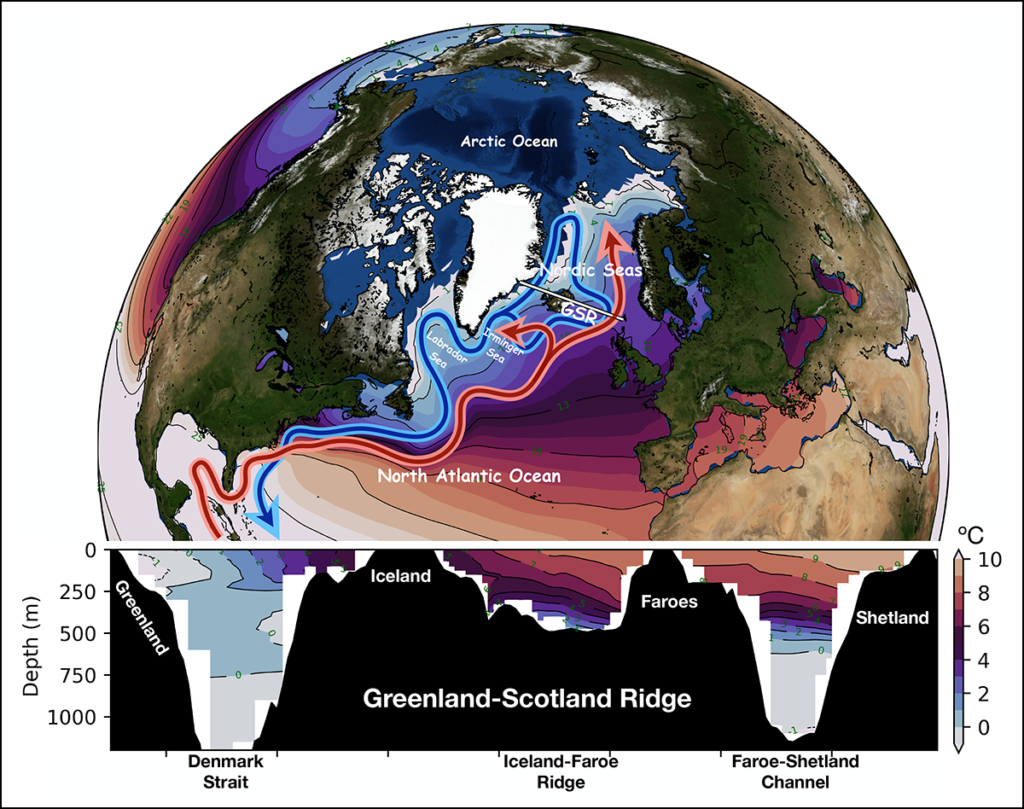The Arctic ocean is weird.
Because of the basin shape and the fact that, whereas in most of the rest of the oceans the temperature gradients, the thermoclines, play the biggest role in mixing/non-mixing of various waters, in the Arctic it's the halocline, the salinity gradient that you have to pay attention to.
And then there are the currents....
From the American Geophysical Union's EOS:
Recent research offers new insights into exchanges of water between the North Atlantic and the Nordic Seas, which play critical roles in the climate-regulating Atlantic overturning circulation.
In the remote reaches of the northern Atlantic, a major ocean current brings warm surface water from the tropics toward the Arctic and returns cold deep water toward the equator. This flow of warm water, known as the Atlantic Meridional Overturning Circulation (AMOC), has played a fundamental role in maintaining the mild climate of central Europe and Scandinavia as we know it today.
We also know that changes in its strength seem to have contributed to well-known climate events in recent millennia, and it continues to modulate global climate today. For example, a weakened AMOC may have played a role in causing almost 600 years’ worth of frigid winters in Europe and North America. This period, called the Little Ice Age, lasted roughly from 1300 until 1870 and came on the heels of the Medieval Warm Period (circa 950–1250), when temperatures in the Northern Hemisphere were unusually warm.
Nearly half of the AMOC’s poleward flow of warm, salty waters enters the Nordic Seas—comprising the Greenland, Iceland, and Norwegian Seas. Here the water cools and pools north of the undersea Greenland-Scotland Ridge (GSR), which spans from southeastern Greenland across Iceland and the Faroe Islands to northern Scotland, before spilling back into the deep North Atlantic (Figure 1). A host of important questions remains about the dynamics of the ocean near the GSR and the effects of these dynamics on regulating climate. The more we know about the variability and driving mechanisms of the exchange of waters across the GSR, the better we can explain and predict future changes in this system.
 Fig. 1. This simplified view (top) shows the surface flows (red arrows) and deep return flows (blue arrows) that make up the large-scale ocean circulation in the North Atlantic. Color bands on the ocean surface indicate average sea surface temperatures from 1900 to 2019 (data are from the Hadley Centre) and highlight the northward extent of warm waters to higher latitudes. The longitude-depth temperature distribution of the ocean (bottom; data are from the World Ocean Atlas 2018) across the Greenland-Scotland Ridge (GSR, white transect line in the top panel) is also shown. The exchange of waters across the GSR is driven by the rapid loss of heat to the atmosphere over the Nordic Seas. This heat loss causes the waters to sink and build a huge reservoir of cold, dense water that spills back into the deep North Atlantic across the GSR, completing the overturning process.
Fig. 1. This simplified view (top) shows the surface flows (red arrows) and deep return flows (blue arrows) that make up the large-scale ocean circulation in the North Atlantic. Color bands on the ocean surface indicate average sea surface temperatures from 1900 to 2019 (data are from the Hadley Centre) and highlight the northward extent of warm waters to higher latitudes. The longitude-depth temperature distribution of the ocean (bottom; data are from the World Ocean Atlas 2018) across the Greenland-Scotland Ridge (GSR, white transect line in the top panel) is also shown. The exchange of waters across the GSR is driven by the rapid loss of heat to the atmosphere over the Nordic Seas. This heat loss causes the waters to sink and build a huge reservoir of cold, dense water that spills back into the deep North Atlantic across the GSR, completing the overturning process.
....MUCH MORE